Blue whales don’t have hands, so they can’t technically be ambidextrous. But just like humans, and lots of other animals, they do have a lateralization bias, or a tendency to favor a particular side. Blue whales tend to be right-biased.
Yet unlike most humans, or any other animal, huge blue whales overcome these lateralization biases, displaying a kind of ambidextrousness when it comes to hunting in tough conditions. A new study, led by researchers at Oregon State University and published in the journal Current Biology today (Nov. 20), analyzed blue-whale behavior and discovered that these massive marine creatures can overcome their right-side biases when hunting krill close to the surface.
The research team tagged 63 blue whales off the coast of California, following their feeding activities for six years with motion sensors. They analyzed 2,800 rolling lunges performed when hunting for krill, the tiny feed that nourishes the world’s largest creature.
When approaching krill at a 90° angle, blue whales turn on their sides. “We found many of them exclusively rolled to their right, fewer rolled just to their left, and the rest exhibited a combination,” said Ari Friedlander, lead author of the study, in a statement. But, when the whales swam upward at a steep angle to hunt krill near the surface, they performed 360° barrel rolls as they gulped their prey—and all turned left, even those that were normally right-biased.
The behavior is remarkable because this conditional ambidextrousness was until now unknown. “To the best of our knowledge this is the first example where animals show different lateralized behaviors depending on the context of the task that is performed,” said study co-author animal behaviorist James Herbert-Read of Stockholm University in Sweden. The blue whales only performed the 360° barrel-roll move when hunting near the surface; the researchers think this helps the whales better keep their eyes on the krill patches which can be hard to see on the water’s surface.
Blue whales typically range from 45 to 135 tons (about 40,000-120,000 kg). Obviously, an animal that size needs to eat a lot, and it appears that when conditions demand it, blue whales get a belly full by any means necessary.
